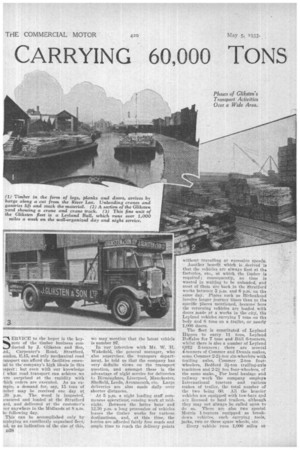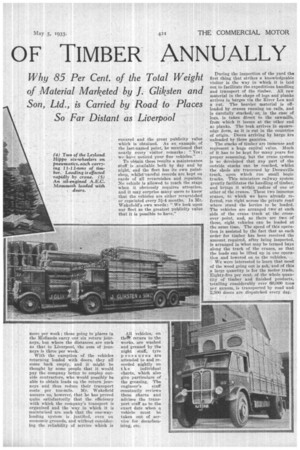CARRYING 60,000 TONS OF TIMBER ANNUALLY
Page 112

Page 113

If you've noticed an error in this article please click here to report it so we can fix it.
Why 85 Per Cent. of the Total Weight of Material Marketed by J. Gliksten and
Son, Ltd., is Carried by Road to Places So Far Distant as Liverpool
ERVICE to the buyer is the key note. of the timber business con
ducted by J. Gliksten and Sort, Carpenter's Road, Stratford, do n (10 , E.15, and only mechanical road ransport can afford the facilities essenial to thecompany's high ideals in this s pe et ; but even with our knowledge what, road transport can achieve we ere surprised at the rapidity with ,hich orders are executed. As an exmple-5 a demand for, say, 15 tons of nriber may be received one day at .30 p.m. The wood is inspected, ieasured and loaded at the Stratford arc], and delivered at : the customer's oor anywhere in the Midlands at 8 a.m. he following day.
This can be accomplished only by mploying an excellently organized fleet, ad, as an indication of the size of this, D38 we may mention that the latest vehicle is numbnr 97.
In -oar interview with Mr. W. TT. Wakefield, the general Manager, who also supervises, the transport department, he told • us that the company has very definite views on the transport question, and amongst these is the advantage of night service for deliveries. to Birmingham, Liverpool, Manchester, Sheffield, Leeds, Avonmouth, etc. Large deliveries are . also made daily over shorter diStanees.
At 5 p.m. a night loading staff commences operations, ceasing work at midnight. Between the latter' bola. and 12.30 p.m. •a long procession of vehicles leaves the timber works for various destinations, and,. at this time, the lorries are afforded fairly free roads and ample time to reach the delivery points without travelling at excessive speeds:
• AnMiler" benefit, Which, is .derived is that the vehicles are always first at tho factories, etc.; 'at which, the -timber is required ; . conseqnently, no . time . is wasted in waiting to be 'unloaded; and most of them . arc' back in the Stratforir works between 5 p.m. and 6 p.m.. on tho same Macs Such -as Birkenhead involve longer journey times than to tho specific places mentioned, -,becanSe: here the . returning vehicles are loaded with doors Made at a.works in the city,. tho Leyland vehicles carrying 7 tons on tha body and 8 tons on a trailer, or nearly 1,000 doors.
. The fleet is constituted of Leyland Hippos to carry 11 tons, Leyland Buffalos for 7 tons and Bull 0-tonners, whilst there is also a number of -Leyland QH2 5-tonners ; there are several 4-tonners of Commer and Dennis makes, some Commer 2-2i-ton six-wheelers with trailing axles, Commer 2-ton fourwheelers, Bedford 3I--ton trailing-axio machines and 2-2 ton four-wheelers. of the same make. 1.4"'or local haulage and railway work the company employs International tractors and various makes of trailer' the total number of the two being 60. All the heavier vehicles are equipped with tow-burs and are licensed to haul trailers, although they may not always .be called upon to do so. There are also two special Morris 1-tonners equipped as breakdown vehicles, each .carrying tools, jacks, two or three spare wheels, etc.
Every vehicle runs 1,000 milesor
more per week ; those going to places la the Midlands carry out six return journeys, but where the distances are such as that to Liverpool, the sum of journeys is three per week. With the exception of the vehicles returning loaded with doors, they all come back empty, and it might be thought by some people that it would pay the company better to employ outside contractors, who would possibly be able to obtain loads on the return journeys and thus reduce their transport costs per ton-mile. Mr. Wakefield assures us, however, that he has proved quite satisfactorily that the efficiency with which the company's transport is organised and the -way in which it is maintained are such that the one-wayloading system is justified, even on economic grounds, and without considering the reliability of service which is All vehicles, on thglt return to the works, ,are washed and greased by the night staff, tyre pressures are attended to and recorded nightly on
t he individual charts, which also give particulars of the greasing. The engineer's staff constantly reviews these charts and advises the tranaport staff as to the exact date when a vehicle must be taken out of service for decarbonizing, etc.
During the inspection of the yard the first thing that strikes a knowledgeable visitor is the way in which it is laid out to facilitate the expeditious handling and transport of the timber. All raw material in the shape of logs and planks arrives in barges via the River Lea and a cut. The heavier material is offloaded by cranes running on rails, and is carefully stacked,or, in the case of logs, is taken direct to the sawmills, from which it issues at the other end as planks. The teak arrives in squareedge form, as it is cut in the countries of origin. Doors arriving by barge are unloaded by three gantries.
The stacks of timber are immense and rep-resent a huge capital value. Much of it has to be kept for many years for proper seasoning, but the crane system is so developed that any part of the outside stacks can be reached, whilst the sheds are traversed by. Decauville track, upon which run small bogie trucks. This miniature railway system greatly facilitates the handling of timber, and brings it within radius of one or other of the cranes. These two immense cranes, to which we have already referred, run right across the private road where stand the lorries to be loaded. The vehicles are arranged two at each side of the crane track at the crossover point, and, as there are two of these, eight vehicles can be loaded at the same time. The speed of this operation is assisted by the fact that as each order for timber has been received the amount required, after being inspected, is arranged in what may be termed bays along the track of the cranes, so that the loads can be lifted up in one operation and lowered on to the vehicles.
We were interested to learn that most of the wood going out is ash, and of this a large quantity is for the Motor trade. Eighty-five per cent, of the whole quantity of timber and finished products, totalling considerably over 60,000 tons per annum, is transported by road and 2,500 doors are dispatched every day.




























































































































































































